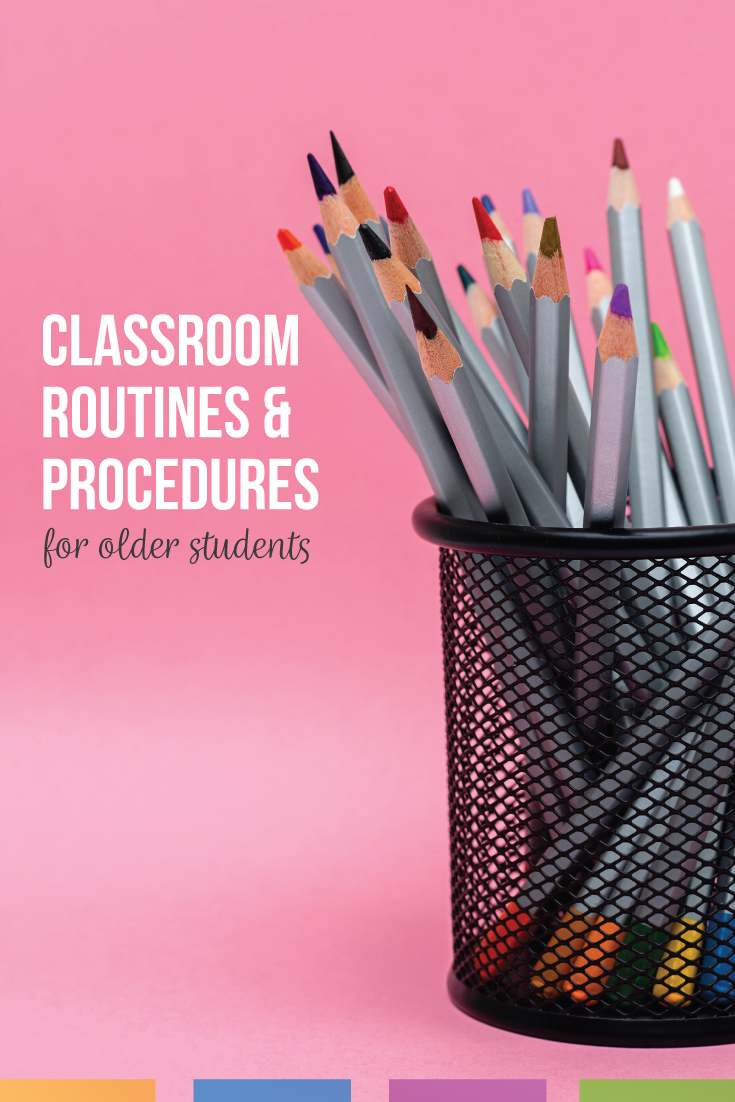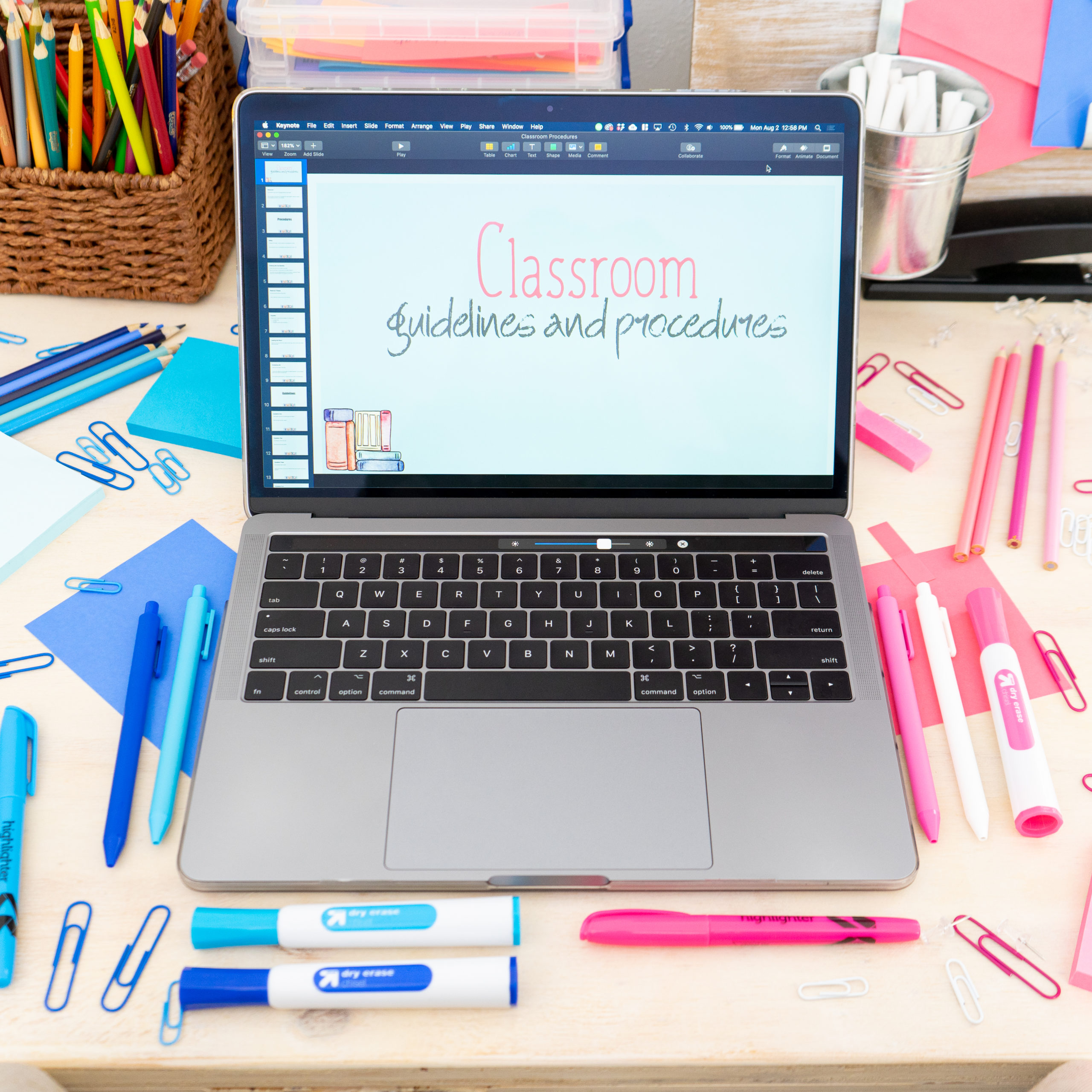I thought of meaningful classroom procedures last night. (I’m a teacher and I do such abnormalities.) Teaching procedures and routines can help in the secondary classroom. How, and why?
I saw a pin of this article from Scholastic. It is largely geared toward younger classrooms but with a few alterations, many tips would work for high schoolers. Older students benefit from classroom procedures, even if they feel like they have outgrown them.
Before I took graduate classes, I didn’t have classroom procedures outside of tornado, fire, intruder, etc. I created some for an assignment and never looked back. Teaching procedures and routines became a norm in my secondary classroom. My classroom management was better, and my relationships with students were better because of classroom routines. Parent questions plummeted, and administrators knew what to expect from my classes. Implementing basic classroom procedures and routines for high school bettered my day-to-day activities. 
Are classroom procedures for older students too young?
No. Older students appreciate consistency in their school days. Consistency provides a safe and predictable classroom culture.
After implementing procedures for basic classroom activities, my room was neater, and I wasted less time quieting and corralling students. Substitutes wrote in their daily notes that the students knew what to do—making their jobs easier. Finally, my students knew what to expect. Older students appreciate that, even if they don’t verbalize it.
While you may not need a procedure for basic activities such as getting a tissue, other procedures can help your classroom run smoothly.
First, decide what needs a procedure. Don’t simply make classroom procedures to say that you have some! Take into account what you want to accomplish from the procedures. That being said, here are several common instances where classroom procedures work nicely.
How do you want students entering the classroom? Should students begin working or wait for your direction?
Possibilities for the start of class include students starting work when entering (such as writing in journals as bell work); students gathering an assignment, book, or notebook from a predetermined spot; or student sitting and opening the previous day’s work.
When students don’t know your expectations, class is started in a mishmash way. Students will find their own sense of “regular” which might include chatting, hanging out in the hall, or playing on cell phones.
I typically start class with an assignment. A successful classroom starts organized. For instance, I write the first activity on the board and put details in Google Classroom.
But! Students know they may look for a book in my classroom library. Normally at the start of class, my students begin their assignments while a few look for books. A few others are filling out requests for First Chapter Friday. (I have material for organizing First Chapter Friday as a free download.) I take attendance and begin walking the room to greet students and start them on the day’s work.
From the beginning of the school year, I run through this valuable classroom procedure. We start class the same way, every day.
Decide if your transitions during class could use procedures.
If students switch supplies or spaces, students may work better if they know your expectations.
Some teachers play music during transitions. Students grow accustomed to the songs and know how much time they have until they should be working on the next activity. I typically give students a time, like 47 seconds.
Then, I help students move their material or set up the next activity. Working physically in the classroom space contributes to the message that we are all on the same team.
Finally, have a systems checklist for small group work. Do you want students in the hall? Are they allowed to spread out? What should they turn in (and where!) at the end of class?
Examine how students leave your classroom.
Are you happy with their exits? If you are picking up papers or supplies, design procedures so students clean after themselves. A secret weapon of productivity is to have students take responsibility for materials. I don’t go as far as assigning classroom jobs, bust students know where material must be returned.
Personalize what works for your classroom. For instance, a pet-peeve of mine is students lining up before the bell rings. Other teachers want their students to leave only after they have verbally dismissed the class. Effective classroom procedures work for your community of learners.
An orderly dismissal also prevents chaos. A physical stampede can actually be dangerous. Tell students you are concerned for their safety, because you are!
Look at basic neatness.
How should students tidy the room? Part of building a classroom community is taking ownership of the physical room. You could make other classroom procedures for turning in papers, making up assignments, submitting late work, and getting/ returning supplies. If you electronically communicate with students, consider guidelines for that too. Look at special circumstances; do students ever share books or electronic devices?
If an area of your room is problematic, discuss it with students. It is their classroom too! What would make this issue better? Do they need a bin for placing materials? The trash can moved? Once you’ve established routines, you can ask students to contribute ideas. A great idea is to include students in the ownership of the room.
Finally, how many classroom procedures for older students are too many? You can always start with 2 or 3 at the beginning of the year. Students expect directions, and many students find comfort in knowing— not having to ask.
Add more if necessary; review procedures with students when necessary. Make meaningful classroom procedures for older students and watch your classroom soar.
Benefits
By teaching classroom routines and procedures, you will build relationships with students by teaching procedures and routines. Some students easily adapt to changes in their lives. Other students appreciate structure and routines. When students know what to expect every day in class, they are not focused on acclimating themselves. Instead they can begin work and behave the way you taught them.
Next, classroom procedures and routines for high school will ease absences, yours or students. When students understand how to begin class and where to find their work, a substitute teacher’s job is easier. When a student is absent, that student knows the expectations.
Teaching classroom routines and procedures made me and my students happier. I didn’t expect them to know every expectation I had. Do I have a routine? Have I explained my procedures? More times than not, when I teach my procedures and routines with secondary students, they are happy to oblige. They simply want to know what they should do. My first day of school for secondary classrooms bundle cover procedures, routines, and organizes you from day one.
If you are looking for more ways to start the school year organized, check out what to expect the first day with high school students.


